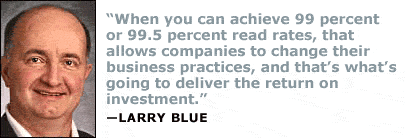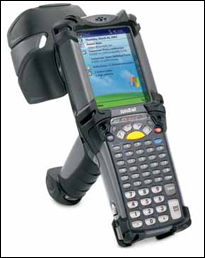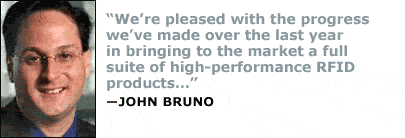Larry Blue was walking near the famed Sydney Opera House in Australia, back in August, when he spotted a discarded airline baggage tag on the sidewalk. The vice president and general manager of Symbol Technologies’ radio frequency identification tag business immediately recognized that the baggage tag was issued in Hong Kong and contained one of his company’s 2- by 4-inch UHF inlays. He peeled it off the pavement and stuck it in his pocket. “When I got back to the office, I waved it in front of one of our interrogators, and it still read,” he says with obvious satisfaction.
Blue likes to recount this anecdote because he sees it as, well, a symbol of his company’s greatest strength—the ability to produce reliable, high-performance UHF RFID systems. Symbol, based in Holtsville, N.Y., is one of the few companies committed to providing both tags and interrogators. The company believes this allows it to offer systems that outperform its competitors’ offerings, giving it an edge in a market that will eventually be crowded with companies offering EPC Gen 2 tags or readers, or both.
|
|
“System performance is the game changer,” says Blue. “When you can achieve 99 percent or 99.5 percent read rates, that allows companies to change their business practices, and that’s what’s going to deliver the return on investment.”
And that’s not Symbol’s only advantage, according to Blue and Philip Lazo, vice president and general manager of Symbol Technologies’ RFID infrastructure business. They say Symbol will be a major player in the market for UHF systems because it also boasts global services and support capabilities, expertise in wireless connectivity and device management, and the ability to partner with software and services companies to deliver solutions for specific vertical markets.
Symbol was something of a latecomer to RFID. The Auto-ID Center was set up in 1999 to develop Electronic Product Code technologies. Symbol joined in early 2002; a year later, in January 2003, Lazo was hired away from Tyco/ADT to run Symbol’s RFID products group. The group began work on a version of its popular MC9000 handheld computer that would be able to read UHF EPC tags.
Still, Symbol remained quiet about exactly what its RFID plans were, as the company had larger issues to contend with. In July 2003, CEO Tomo Razmilovic resigned and fled to Sweden as U.S. regulators uncovered evidence of accounting fraud. William Nuti, who had joined the company from Cisco in 2002 as president and chief operating officer, took over and brought in his own team, including John Bruno, who is now senior vice president and general manager of the RFID team. Lazo and Blue both report to Bruno.
Nuti put the company’s house back in order and, in July 2004, made a bold move into the RFID market when Symbol acquired Matrics, one of two high-profile startups then focused on the EPC market (the other was Alien Technology), for the eye-popping sum of $230 million (see Symbol Acquires Matrics). The move immediately made Symbol a major player in the market. Matrics not only had well-regarded technology, it also had won a number of major contracts, including one with a major retailer (the customer required Matrics to sign a nondisclosure agreement).For the past 18 months, Symbol has been integrating Matrics into its organization. It kept the Matrics office in Hanover, M.D., and Lazo moved to Maryland to manage the division (Blue worked at Matrics and was already based there). Symbol has also been upgrading Matrics’ hardware to support the EPC Gen 2 air-interface protocol, to make those products compatible with Symbol’s own mobility software suite and to continue to build the RFID business.
Lazo says work in all areas is progressing, and that 2005 was a good year for the RFID unit. “We’ve said publicly that we’ll be around $40 million in total RFID revenue,” he says. “The third quarter was a great quarter for us, with about $15 million in revenue. We had a number of customer wins.”
Symbol has three main interrogator products: the XR400 and AR400 fixed-position readers, and the MC9000-G handheld computer/interrogator. The XR400 is a high-end interrogator that uses the Intel XScale processor and Windows CE operating system. It has 64 megabytes of flash memory and 64 MB of SDRAM to run software applications native to the reader. The U.S. version of the reader lists for $2,690.
In September, Met Laboratories, a testing company hired by EPCglobal to test standards compliance, certified the XR400 as compliant with the EPC Gen 2 air-interface protocol. In November, Symbol released firmware enabling the interrogator to support dense-reader mode, allowing a large number of interrogators to operate in the same environment without interfering with one another. Symbol expects to release firmware that will make the AR400 Gen 2-compliant in the first quarter of 2006.
To lower the total cost of ownership and reduce installation time, Symbol developed two portal systems, the DC600 and the DC400. Both feature an XR400 interrogator in a hardened metal case that can be bolted to the floor between dock doors. The case protects it from being damaged by forklifts and other operating equipment. The DC600 has some additional features, including integrated lights to indicate when a tag has been read, a power-entry module to eliminate the need to run conduit to protect the electrical wires powering the device and a slimmer housing (4 inches wide) to enable the unit to fit into smaller spaces. With one reader and four antennas, the DC600 lists for $4,999.
In October 2004, Symbol announced the general availability of its MC9000-G ruggedized handheld computer/interrogator. This featured a large screen and keypad, 802.11b (Wi-Fi) wireless LAN capability, an integrated bar code scanner and a built-in RFID reader and folded yagi antenna (a type of directional antenna similar to the ones people mount on homes to receive broadcast television signals).
The handheld, which operates at 915 MHz, was based on EPCglobal’s Class 1 EPC specification and had a list price of $4,845. Symbol expects to release a Gen 2 version of the MC9000 in the first quarter of 2006 that will be able to read both Gen 1 and Gen 2 tags. A firmware upgrade to enable the reader to support dense-reader mode will be available later in the year.Differentiating Symbol Products
Financial analysts have raised questions about what specifically Symbol got when it acquired Matrics. The startup had won several major contracts for its Gen 1 EPC technology, but with end users moving rapidly to Gen 2 technology, Matrics’ performance edge could be lost. Blue doesn’t think so.
“We’re investing in tags and readers, so we’re able to take advantage of that synergy,” he says. “I have a reader team right down the hall, so when my team is designing a new tag and we have performance issues, we can immediately talk to Phil and his team and come up with a way to optimize the solution. Our ability to solve problems—and they come up because this is an emerging technology—and create a total solution is very powerful.”
After EPCglobal’s board of governors ratified the Gen 2 specification in December 2004, Symbol said it would start to provide Gen 2 readers, tags and terminals to its Gen 2 early adopter evaluation program customers starting in the second quarter of 2005. The company expected its Gen 2 hardware to reach full commercial availability at the end of the same quarter (see What’s Next for Gen 2).
Symbol demonstrated its Gen 2 tags and readers in June of 2005, along with Philips and IBM (see Symbol, Philips Demo Gen 1 and 2). The manufacturer says its Gen 2 tag strategy has always been to work with partners to obtain chips for its first Gen 2 products. However, the availability of Gen 2 chips used to make the tags was held up by EPCglobal’s certification process (the first chips were certified in September; see EPCglobal Certifies Gen 2 Hardware), and by a delay in the production of the Philips Gen 2 chip, which was recently certified as Gen 2-compliant (see Philips’ Gen 2 Chip Gets Certified).
Matrics designed its own EPC Gen 1 microchips. Blue says Symbol’s plan is to do the same with Gen 2, but in the short term, the company will use chips designed by Impinj and Philips Semiconductor.
“The first thing that’s important to do is to establish the Gen 2 standard as an interoperable standard,” he says. “The goal is to get out with a product that’s generally available from lots of other vendors. So we’ve announced a relationship with Philips and Impinj. We waited for both to be certified before we started working with them, because we wanted them to be blessed as meeting the Gen 2 requirements.”Symbol has an internal effort underway to develop its own microchip, which it believes is an important strategic effort, enabling Symbol to save money by buying chips directly from a semiconductor manufacturer and, thereby, provide a higher-performance system at a lower cost. It will also enable Symbol to add some additional features that go beyond those called for in the specification for the standard, but which customers may want, such as additional memory. (The Impinj chip does have two RF ports to allow two antenna connections, which means Symbol will be able to use it to manufacture a tag that has its patent dual-dipole antenna, making the tag readable regardless of its orientation to the reader.) Symbol says tags based on its own silicon will be available in the first quarter.
Blue concedes that Symbol had some problems delivering Gen 1 tags to customers in 2005. He says that was because Matrics was a small company that had outsourced the manufacturing of inlays, tags and labels to third parties. When it won several large orders, including supplying McCarran Airport with 20 million tags per year for five years (see Las Vegas Airport Bets on RFID), the supply chain couldn’t keep up with demand.
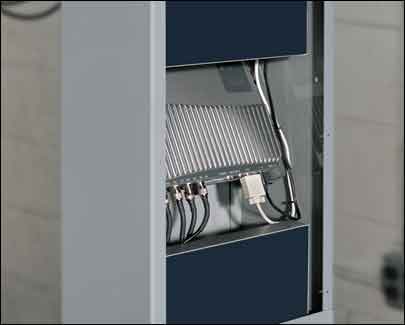
According to Blue, Symbol has invested $20 million in Muehlbauer inlay assembly machines and can now assemble 400 million inlays per year. Two-thirds of the capacity has been installed at the company’s production facility in Reynosa, Mexico, the rest at the facilities of a contract manufacturer in Asia. All of the capacity is online, so Blue believes Symbol will be able to meet demand in 2006.
The first Gen 2 inlays will start rolling off the machines in the first quarter of this year. Symbol is also investing in a high-speed assembly technology called PICA, or Parallel Integrated Chip Assembly. Developed by Matrics, the technology can reportedly be used to produce hundreds of millions of tags per year (see Symbol Says PICA Ready in Mid-2006).
Still, Blue doesn’t expect to see a huge demand for Gen 2 tags until the second half of the year. He says early adopters will test the tags first in labs, and then in a production environment, before making volume purchases. “I don’t see demand for Gen 2 tags reaching parity with Gen 1 until the middle of next year,” he says.
The company has developed seven standard inlays, including a 1- by 1-inch item-level tag, a 2- by 4-inch airline baggage tag, a 3- by 3-inch pallet tag and a 4- by 4-inch cart tag. Blue says the company will produce Gen 2 tags in all seven of these formats, and that during 2006, it will introduce a number of special form factors. These will include tags designed for use on metal products or objects, and tags that can be embedded into DVDs and CDs (these tags actually use the aluminum layer on the CD or DVD as the antenna).New Interrogator Form Factors
Symbol plans to have an interrogator that complies with the new European Telecommunications Standards Institute (ETSI) standards for the European market in the first quarter of 2006. It is also developing interrogators in new form factors, including one that can be mounted on a forklift. In early 2006, the company will begin working with key customers to test the forklift interrogator in production environments. The product should be available by the middle of the year, he says.
Additionally, the company is working on an interrogator that will have a single integrated antenna. (Applied Wireless Identifications Group (AWID) is one of the few companies currently offering a UHF interrogator with an integrated antenna.) This type of reader is attractive in applications where a number of low-cost interrogators can be mounted along conveyors or other operational areas to ensure a tag is read in at least one location. “One of the things we’re doing is trying to miniaturize the solution so you can embed [the interrogator in the environment],” says Lazo. “We can leverage our wireless history to have these points talk very efficiently to each other.”
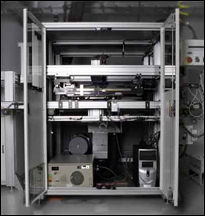
Lazo says Symbol’s 30-year history in creating ruggedized handheld devices is a strategic advantage to the company, particularly when combined with the expertise in antenna design that came with the Matrics acquisition. “It doesn’t take long to build a great antenna,” says Lazo. “But it takes 30 years to build a good antenna engineer. We’ve got those people and can take advantage of their expertise.”
Leveraging Symbol’s Assets
Lazo sees Symbol’s ability to deliver high-performance systems to the market as his company’s key competitive advantage because its current and potential customers will be able to change their business processes only when they can read tags with 99 percent accuracy or better—but it’s not Symbol’s only advantage.
“We’re a big company with significant supply chain capabilities,” Lazo says. “When a customer wants 10,000 readers, we can build them quickly and deliver them. As this business scales and there are enterprise-wide rollouts, our internal manufacturing capabilities and relationships with large contract manufacturers are a competitive advantage.”
Symbol also has a global services and support organization that can handle large-scale rollouts. During the past 18 months, the company has been training people at call centers to answer questions about its RFID products, establishing teams at regional service centers to repair RFID readers. In addition, Symbol’s professional services group has absorbed some of the expertise from Matrics, allowing service engineers to do site surveys and install RFID solutions. “We believe it’s a critical requirement for a large company with a large rollout to deal with a technology provider large enough to have the customer service infrastructure to support the rollout,” says Lazo.
Lazo’s team has also been working to integrate its RFID products with some of Symbol’s existing wireless infrastructure products, particularly its Mobility Services Platform (MSP), a software suite that helps IT managers deploy mobile computers, monitor them, manage applications and upgrade software remotely. Symbol’s MC9000-G RFID handheld computer can already be managed with the MSP suite. The company’s goal is to build the components of the MSP suite into its fixed readers so they, too, can be managed remotely with the same platform that its customers are using to manage their mobile devices.
MSP doesn’t filter RFID data, however. Symbol’s goal is to work with a wide variety of middleware providers so their products will take data from Symbol readers and pass it on to enterprise systems. In turn, these middleware partners could use MSP’s capability to manage RFID interrogators. Lazo believes this ability to be managed remotely with Symbol’s existing MSP product adds value to the interrogators.Symbol is also looking to leverage its history of working with third parties to develop solutions for specific industries. By partnering with EPC Solutions for software that assigns and manages EPCs, and with Zebra Technologies for a printer-encoder, it has created a package of products enabling companies to meet their customers’ tagging mandates.
Lazo says Symbol will also work with other vendors to create solutions for specific industries. “Our reader architecture has been upgraded to make it more partner-friendly,” he says. “That is, it will be easier for partners to develop native applications that can run on our readers, which enables us to develop solutions for specific verticals.”
One way Symbol has made it easier for others to develop applications to run on its interrogators is by making Windows CE the operating system for the XR400 (see Symbol Puts Windows in Reader). Symbol already has a community of software developers among its partners that can add value to interrogators by writing applications. Symbol is also creating new application program interfaces (APIs) and development tools for partners to encourage the development of new applications that could run on its readers. The new APIs will be backward-compatible with the APIs currently used in its interrogators.
At the same time, Symbol wants to develop more relationships with distributors and value-added resellers that can sell its products. It has already certified more than 75 partners as official resellers. The long-term goal is to sell 75 to 80 percent of its RFID products through these partners, as it does with other Symbol products. Today, however, Symbol sells most RFID systems directly to customers, and that is likely to be the case for the next couple of years, as the market matures. In fact, Lazo says Symbol will expand its internal RFID sales efforts to Europe, Asia and Latin America.
Moving Forward
Symbol is the dominant player in the market for bar code scanners, but it’s not clear yet whether it can take advantage of its UHF RFID expertise, size advantage, support organization and partner network to dominate the RFID market. One company potentially standing in its way is Intermec Technologies, an historical competitor in the bar code market. Intermec also plans to invest in its tag and reader product line; it has significant UHF RFID intellectual capital, a strong services organization and a significant customer base.
The rivals had planned to wage their first battle in court over intellectual property, but Symbol instead chose to come to terms with Intermec on use of Intermec RFID patents (see Intermec, Symbol Reach Major Agreement). The two firms have not yet settled all their outstanding grievances, but Lazo says they are talking. There is no timetable for a resolution.
The key for Symbol in the short-term will be getting Gen 2 tags and interrogators to market quickly and consistently, proving those products can outperform others and leveraging all the advantages Symbol has as one of the largest players in the market. John Bruno, for one, believes it can achieve those goals.
“We’re pleased with the progress we’ve made over the last year in bringing to the market a full suite of high-performance RFID products that have enabled us to differentiate ourselves from our competitors and successfully put RFID to work for our customers,” Bruno says. “As we build on our market share leadership position and our Gen 2 products gain traction while entering new vertical and geographic markets, 2006 promises to be another exciting year.”

